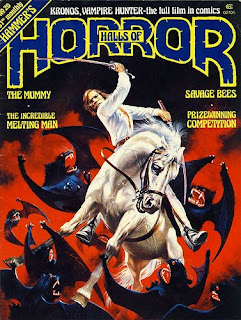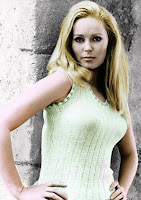CAPTAIN KRONOS VAMPIRE HUNTER (1974)
 CAPTAIN KRONOS VAMPIRE HUNTER was adapted into comics for Hammer’s Halls of Horror #20 (May 1978), and an original strip featuring the character also appeared in the first three issues of the magazine.
CAPTAIN KRONOS VAMPIRE HUNTER was adapted into comics for Hammer’s Halls of Horror #20 (May 1978), and an original strip featuring the character also appeared in the first three issues of the magazine.
AS Hammer entered the 70s, new ideas were sought to revitalise their outdated mythologies. A potential saviour came in the form of THE AVENGERS alumni Brian Clemens, who created fresh adaptations of two renowned horror themes. The first, DR JEKYLL & SISTER HYDE - directed by Roy Ward Baker - sees Jekyll (Ralph Bates)'s obsessive quest for the elixir of life make him change sex into Hyde (Martine Beswick). A decidedly kinky reversal of the familiar tale, Bates' creepy austereness is countered perfectly by Beswick's blatant full-bodied sexuality. It has the look of Oliver!, with its cheeky street urchins and gin-swilling tarts, but Clemens' off the wall approach encompasses too much: the jovial threads of Jack the Ripper, Dorian Gray, Burke and Hare and Sweeney Todd jar somewhat with the disturbingly frenzied stabbings of Betsy (Virginia Wetherell) and Professor Robertson (Gerald Sim).
Clemens' second Hammer screenplay proved to be every bit as iconoclastic as his first. The sleeper CAPTAIN KRONOS VAMPIRE HUNTER - directed by Clemens himself - has the swash-buckling, eponymous hero (Horst Janson) seeking to destroy a vampire clan who drain youth rather than blood. Although dubbed by Julian Holloway, Janson gives a brooding performance for what is an outstanding creation; the character of Kronos is fleshed out by an intriguing back-story (his mother and sister were vampires) and memorable sidekicks (hunch-backed Professor Grost (John Cater), gypsy Carla (Caroline Munro)). The film also created a whole new vampire lore; not only are victims emaciated, different methods kill specific breeds, dead toads buried in boxes will spring to life if a vampire walks across it, and flowers will wilt in the undead's wake.
Clemens' second Hammer screenplay proved to be every bit as iconoclastic as his first. The sleeper CAPTAIN KRONOS VAMPIRE HUNTER - directed by Clemens himself - has the swash-buckling, eponymous hero (Horst Janson) seeking to destroy a vampire clan who drain youth rather than blood. Although dubbed by Julian Holloway, Janson gives a brooding performance for what is an outstanding creation; the character of Kronos is fleshed out by an intriguing back-story (his mother and sister were vampires) and memorable sidekicks (hunch-backed Professor Grost (John Cater), gypsy Carla (Caroline Munro)). The film also created a whole new vampire lore; not only are victims emaciated, different methods kill specific breeds, dead toads buried in boxes will spring to life if a vampire walks across it, and flowers will wilt in the undead's wake.
CAPTAIN KRONOS VAMPIRE HUNTER effectively portrays the English countryside in perpetual autumnal decay. Clemens seems set on desexualising his vampires (their quest for youth is not so much driven by their unchecked libido as it is by a self-admiration), and his direction makes the film move with an agility that many latter-day Hammer's lacked. Yet both these brave attempts didn't appeal to the cinemagoers of the day. While Hammer's own feature version of ON THE BUSES was breaking house records during its first days of release, the double bill of DR JEKYLL & SISTER HYDE and BLOOD FROM THE MUMMY’S TOMB managed only a meagre showing in its opening week at London's New Victoria. Similarly, with no assured distribution, CAPTAIN KRONOS VAMPIRE HUNTER - whose principal photography actually wrapped nearly two years previously - was barely released.



